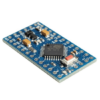Pro Mini ATMEGA328P 5V/16M (Official Version)
In stock
- Microcontroller: ATmega328P
- Circuit Operating Voltage: 5V
- Clock frequency: 16MHz.
- 6 PWM port: D3, D5, D6, D9, D10, D11.
- Use For Atmel Atmega328P-AU microcontroller.
- Support serial download.
- Support 9V battery.
- A pair of TTL level serial port transceiver : RX / TX.
₹250.00 ₹399.00 (Price Excl. GST) ₹211.86
In stock
CompareThis is a Pro Mini 5V Arduino running the 16MHz bootloader. Pro Mini ATMEGA328P comes without connectors. We recommend that first-time Arduino users start with the Uno R3. It’s a great board that will get you up and running quickly. The Arduino Pro series is meant for users who understand the limitations of system voltage (5V), lack of connectors, and USB off-board.
The Pro Mini ATMEGA328P 5V/16M is a microcontroller board based on the ATmega328. It has 14 digital input/output pins (of which 6 can be used as PWM outputs), 6 analog inputs, an on-board resonator, a reset button, and holes for mounting pin headers. A six-pin header can be connected to an FTDI cable to provide USB power and communication to the board. The Pro Mini Arduino is intended for semi-permanent installation in objects or exhibitions. The pin layout is compatible with the Mini Arduino.
Features :
- ATmega328 running at 16MHz with external resonator (0.5% tolerance)
- 0.8mm Thin PCB
- USB connection off board
- Supports auto-reset
- 5V regulator
- Max 150mA output
- Over-current protected
- Weighs less than 2 grams!
- DC input 5V up to 12V
- Onboard Power and Status LEDs
- Analog Pins: 8
- Digital I/Os: 14
- 0.7×1.3″ (18x33mm)
Useful Links :
Getting Started with Arduino Pro Mini
Package Includes :
1 x Pro Mini ATMEGA328P 5V/16M (Official Version)
Specifications
| Microcontroller | ATmega328P |
|---|---|
| Input Voltage (V) | 5 to 12 |
| Clock Frequency (MHz) | 16 |
| Analog I/O Pins | 8 |
| Digital I/O Pins | 14 |
| PCB Size ( L x W ) mm | 33 x 18 |
| Shipping Weight | 0.08 kg |
| Shipping Dimensions | 10 × 5 × 5 cm |
Shipping & Returns
Due to the type of products we sell, we accept limited returns. Below are the conditions where we can accept a return request.
MANUFACTURING DEFECT
If you receive a product with a manufacturing defect, please notify us within 1 day of receiving the product, supported by the proper pictures and description. Once our support team accept the return, we will provide a replacement or a complete refund including the return shipping cost.
WRONG ITEM SHIPPED
If you receive a different product than the ordered one, please contact us within 1 day of receiving the product, supported by the proper pictures and description. Once our support team accept the return, we will provide a replacement or a complete refund including the return shipping cost.
LIMITATION OF RETURNS
We don’t accept returns for products damaged by improper use of the product. Moreover, we don’t accept the return if the ordered product is unsuitable for any specific application. Please read the product specifications and datasheet before selecting and ordering a product.
WHAT VOID WARRANTY?
If the product is subject to misuse, tampering, static discharge, accident, water or fire damage, use of chemicals & soldered or altered in any way.
SHIPPING
We ship all over India. Please contact our support team at info@inventkart.com for any questions related to shipping.
Based on 0 reviews
Be the first to review “Pro Mini ATMEGA328P 5V/16M (Official Version)”
You must be logged in to post a review.














There are no reviews yet.